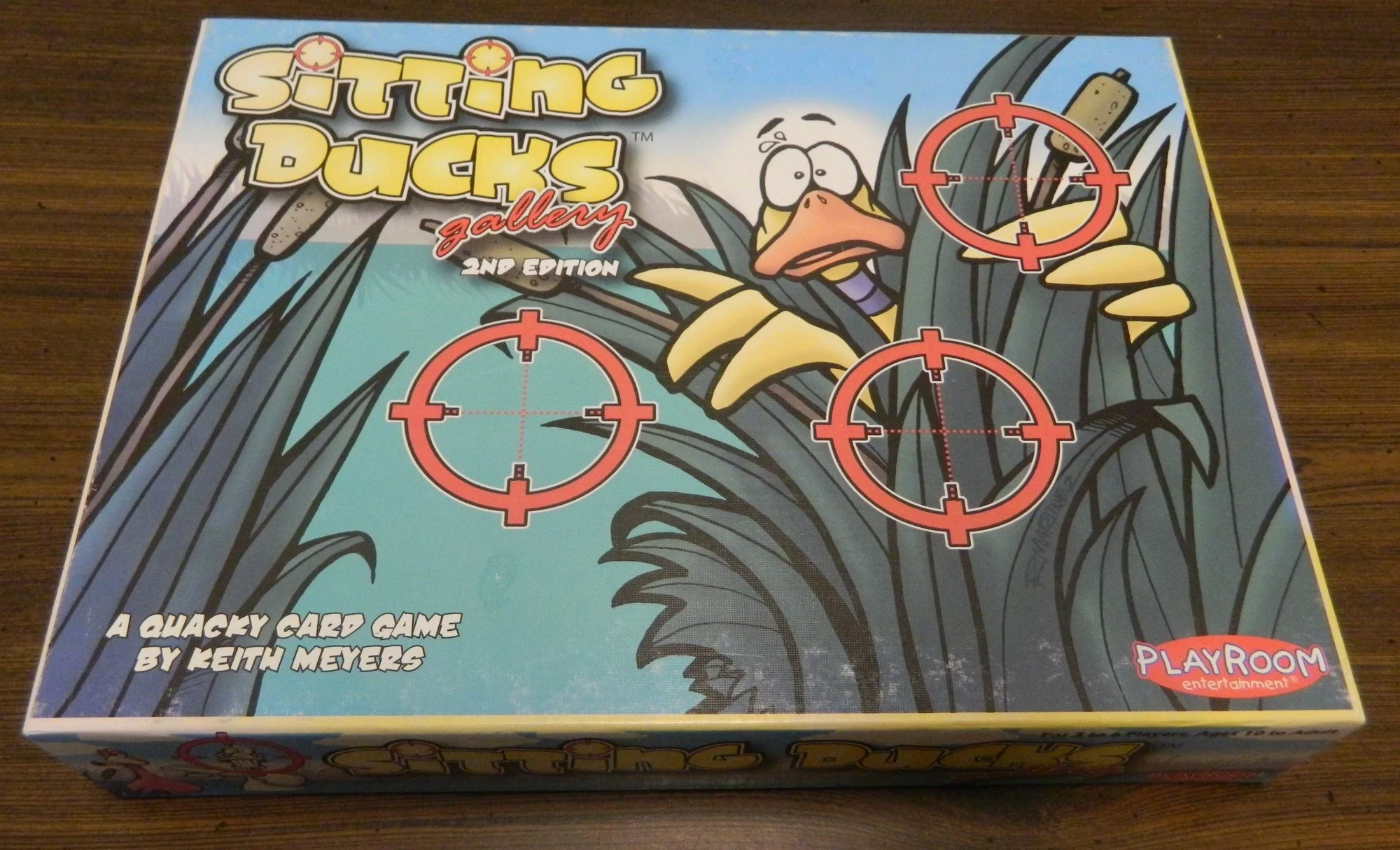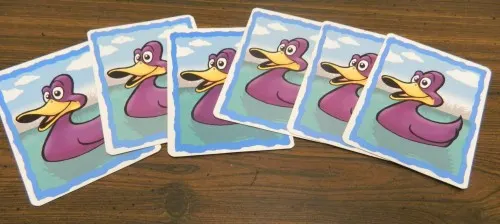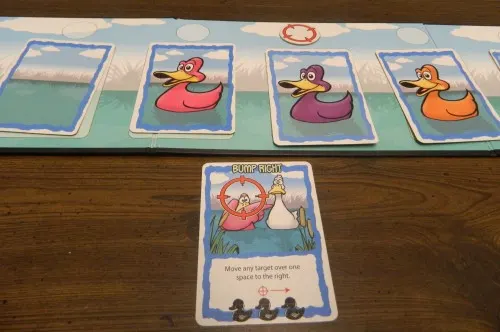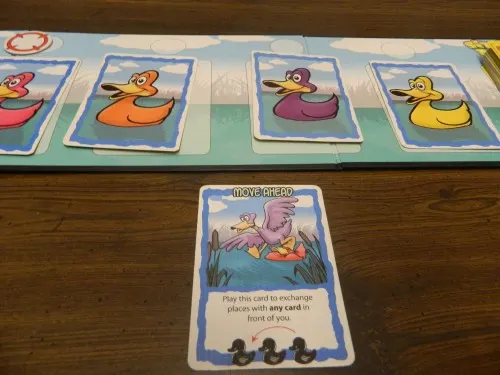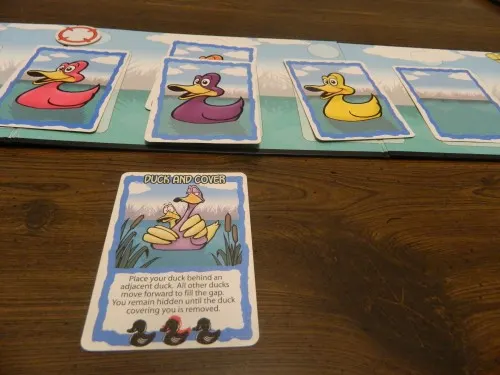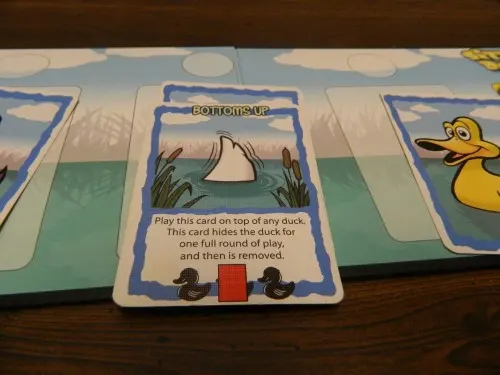How to Play
Objective
Have the last duck remaining.
Setup
Sort all of the duck cards by their color. Each player takes one color of ducks. The duck colors not chosen by a player are removed from the game. Each player places one of their cards in front of them to indicate their color. The other cards are shuffled with the “empty water” cards to form the duck deck. The top six cards from the duck deck are dealt out to the gameboard from left to right.
Shuffle the action cards and deal three to each player. The rest of the action cards form the draw pile.
The color of the duck first in line determines who plays first.
Playing the Game
A player starts their turn by playing one of their action cards. A player must play a card even if all of their action cards will hurt themselves. The effects of the card played are applied and the player draws a new action card. If none of the player’s cards can be played, the player can discard one of their cards for no effect.
When ducks are shot they are removed from the board and are given to the player of the matching color. When a duck is shot, all ducks behind the shot duck are moved forward and a new card is drawn from the duck deck to fill in the last spot. When a player has all six of their ducks in front of them, they can no longer win the game. The player still plays cards on their turn.
Card Abilities
Take Aim: Place a target marker over one of the spots on the gameboard. This space is targeted and can be fired at with a future card.
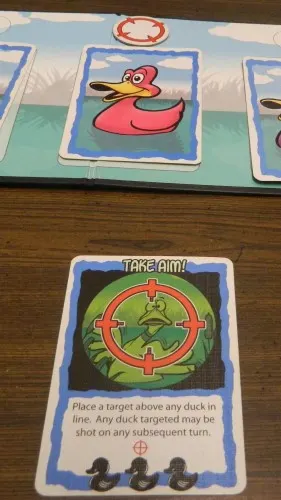
The current player has played a Take Aim card and has chosen to target the space currently occupied by the pink duck.
Shoot: Shoots at one of the target markers on the gameboard. If there are multiple targets on the gameboard the player who played the card gets to choose which one to shoot at. The target marker that is shot at is removed from the board. If a duck is shot at it is removed from the game and all of the cards in the duck line are moved one spot up to fill the empty spot. If an open water card is shot, the target marker is removed but the water card stays in the same spot.
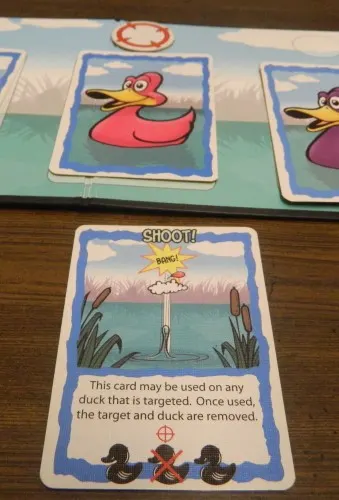
By playing the Shoot card, the pink duck is shot. The pink duck is removed from the board and returned to the pink player. The target is removed from the gameboard as well.
Double Barrel: Shoots two adjacent targeted spaces. If there are aren’t two targeted spaces that are adjacent, this card can’t be used.
Quick Shot: Works as a take aim and shoot card so it can shoot spaces that aren’t currently targeted. If the space shot at was already targeted, the target is removed from the gameboard.
Misfire: Shoot at a duck next to a duck that is currently being targeted. Remove the target that is used by the card (on the space adjacent to the duck that is shot).
Two Birds: Shoots two adjacent ducks that both have a target over them. If there are no areas where two ducks are targeted next to one another, this card cannot be played.
Bump Left/Bump Right: Move the target marker one space to the left/right. If a target is all the way to the left/right it cannot move any further left/right. A target also can’t be moved onto a space that is already targeted.
Line Forward: Move each duck card forward one space. The duck at the front of the line is removed from the board and placed at the bottom of the duck pile. The top card from the duck pile is put in the last spot of the duck line.

The current player played the Line Forward card. All of the cards are pushed forward one space. The purple duck that is pushed off the gameboard is put on the bottom of the draw pile.
Hanging Back: You can swap one of your ducks (matching your color) with the duck right behind it. If your duck is last in the duck line, this card can’t be used.
Move Ahead: You can swap one of your ducks with the duck immediately in front of it. If your duck is the first duck in line, this card can’t be used.
Fast Forward: This card allows you to move one of your ducks to the front of the line. This card can only be used on your own ducks.
Disorderly Conduckt: You can rearrange the duck cards in the duck line in any way that you want. The targets do not change positions.
Duck Shuffle: Take all of the cards from the duck line and combine them with the cards in the duck pile. Shuffle all of the cards and deal six new cards to the duck line. Targets are not rearranged.
Duck and Cover: You can place one of your ducks behind an adjacent duck (not empty water). If there are no ducks adjacent to one of your ducks, you cannot play the card. All the cards behind the moved card are moved forward to fill in the gap. These two cards are moved together so both are removed from the gameboard if they are moved off the gameboard. If the front duck is shot, it is removed from the game but the duck using Duck and Cover remains on the gameboard but is now vulnerable.
Bottoms Up: This card hides a duck for a full round. After the round ends the card is discarded. If the duck is shot at, the target is removed from the space but the duck is not harmed.
Winning the Game
When all but one player has lost their final duck, the remaining player wins the game.
Review
Being made by Playroom Entertainment, it is not surprising that Sitting Ducks Gallery is a family game. The game is a lighter strategy game that is easy to learn and play. You can teach the game in minutes and play a game in 20-30 minutes. With its’ simplicity Sitting Ducks Gallery would work really well as a family game or a game to play with non-gamers.
If I were to compare Sitting Ducks Gallery to another game I would have to say that it plays a lot like Guillotine. Sitting Ducks Gallery is a simpler game than Guillotine and is more family friendly. The premise of moving cards along the line though is very similar between the two games. If you have played Guillotine before and are looking for a lighter version to play with children I would suggest looking into Sitting Ducks Gallery. If you don’t really care for the theme of Sitting Ducks Gallery or want a more strategic game, I would look into Guillotine.
The main strategy in Sitting Ducks Gallery is to try to get your ducks out of the duck line as quickly as possible. When your cards are in the deck they are safe so the quicker you can get your ducks back to the deck, the better off you will be. This is the most interesting part of the game. At times you actually can have a pretty big impact on your fate in the game.
Unfortunately the game doesn’t live up to its’ potential in this area. There are not enough cards in the game that allow you to mess with the order of the cards in the duck line. You can sometimes move your ducks forward in the line but it doesn’t happen enough to have a real impact on the game. Too often luck will determine which ducks are lucky enough to safely leave the duck line and get put back into the duck pile. The players whose ducks are at the bottom of the deck to begin the game are also at a pretty big advantage because their ducks will likely be exposed for less time than the other players’ ducks.
At times is that some of the action cards appear to be a little too overpowered. There aren’t many of these cards in the game but if you get one of them you can have a big impact on the game. The most powerful card in the game in my opinion is probably the Duck Shuffle card. I find this card to be so powerful since it lets you mix up the entire game. If a bunch of your ducks are in danger you can change the entire duck line which could save several of your ducks from danger.
One of the more interesting elements in the game is the fact that you actually may be forced to hurt yourself. Since you have to play a card every turn, you could be forced into playing a card that hurts yourself. In one game I was forced into shooting one of my own ducks. All I had were shoot cards and my duck was the only duck with a target on it. I thought this would be a rare occurrence but it happens more often than you would think since there will be several instances each game where a player is forced into helping out another player due to the cards in their hand.
Sitting Ducks Gallery tends to have a problem where all of the ducks are eliminated at a pretty even pace. Outside of some really bad luck all of the players will be very close at the end of the game. This occurs because if any player gets ahead of the other players, all of the other players target that player in order to bring them back into the pack. Between two of your turns you could easily go from first to last or even out of the game since there is little you can do to protect your ducks between your turns.
This brings me to the rule that eliminated players still have the opportunity to play cards. I don’t know what to think about eliminated players being able to determine who ultimately wins the game. I like the idea because it keeps all of the players engaged instead of forcing them to sit there with nothing to do. It is still not that exciting for these players though since they can’t win so all they are doing is helping decide who ultimately wins the game. This gives these players a lot of power and can easily make them kingmakers who end up deciding who ultimately wins the game. If you hate kingmaking situations where one player get to decide who wins the game, you might hate this rule.
The theme of Sitting Ducks Gallery is interesting since I can’t think of a game that I have ever played with a similar theme. The theme actually works with the gameplay since moving ducks along the duck line does a good job simulating a shooting gallery. While the game has a lot of shooting in it, I think the theme is pretty harmless overall. Some parents might find the theme a little inappropriate for really young children but I don’t really see a problem with the theme. The artwork on the cards is far from violent and is pretty humorous for the most part. The artwork in general is really well done in my opinion.
While Sitting Ducks Gallery is a fun game in its’ own right, I actually think the game could be improved with some house rules. One rule I really want to try out someday is to add a deception/deduction element into the game. While I haven’t tried it yet, I think it would be really interesting to play the game where none of the players know who the other players in the game are. You would play the game with all of the ducks being used which would mean some of the ducks wouldn’t be controlled by any of the players. All movement cards could be applied to any ducks which would allow players to hide their identities.
I think this would make Sitting Ducks Gallery more interesting because it would add more strategy to the game. You would have to actually try to hide your identity which means that you would have to take actions to help your own ducks as well as help other ducks. Players would be forced to try and deduce the other players colors. Players could either risk going after specific colors with the chance that they pick the wrong colors or they could spread out their attacks to hit all of the ducks.
Component wise there isn’t much to complain about Sitting Ducks Gallery. As I already mentioned, the artwork on the cards is really good. Some of the card text could have been written better though in order to make them a little more clear. As a matter of fact the text on the “Hanging Back” and “Move Ahead” cards are quite misleading. This was supposedly fixed in later printings of the game.
Final Verdict
Overall Sitting Ducks Gallery is a good game. The game is pretty light on the strategy side but you can still have quite a bit of fun with the game. Sitting Ducks Gallery is quick to learn and play as well as simple enough to play with children and non-gamers. The game has some interesting mechanics but I wish the game did more with them. Luck plays too big of a role in the game.
If you think the game’s concept sounds interesting, I think you will like Sitting Ducks Gallery since it is a fun little filler card game. If the theme doesn’t really appeal to you though or you are looking for more strategic games, there are probably better games out there with one possibility being Guillotine.
If you would like to purchase Sitting Ducks Gallery you can purchase it on Amazon. Sitting Ducks Gallery

